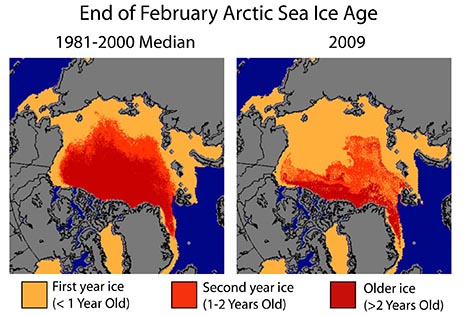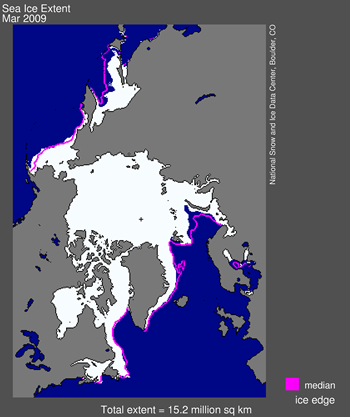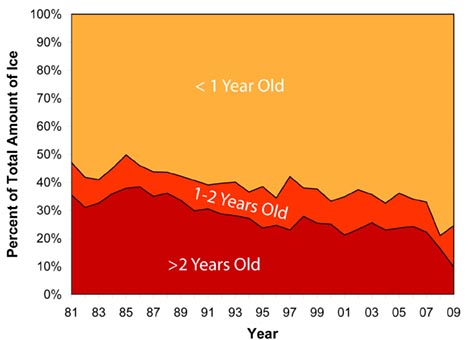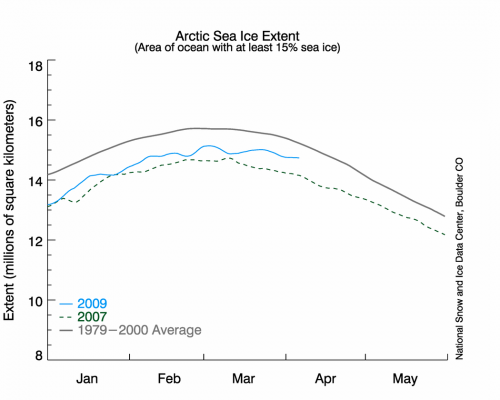The latest data from NASA and the University of Colorado at Boulder’s National Snow and Ice Data Center show the continuation of a decade-long trend of shrinking sea ice extent in the Arctic, including new evidence for thinning ice as well.
The researchers, who have been tracking Arctic sea ice cover with satellites since 1979, found that the winter of 2008-09 was the fifth lowest maximum ice extent on record. The six lowest maximum events in the satellite record have all occurred in the past six years, according to CU-Boulder researcher Walt Meier of NSIDC.
The new measurements by CU-Boulder’s NSIDC show the maximum sea ice extent for 2008-09 reached on Feb. 28 was 5.85 million square miles, which is 278,000 square miles below the average extent for 1979 to 2000, an area slightly larger than the state of Texas, said Meier.
In addition, a team of CU-Boulder researchers led by Research Associate Charles Fowler of the Colorado Center for Astrodynamics Research, or CCAR, has found that younger, thinner ice has replaced older, thicker ice as the dominant type over the past five years, making it more prone to summer melt.
“Ice extent is an important measure of the health of the Arctic, but it only gives us a two dimensional view of the ice cover,” said Meier. “Thickness is important, especially in the winter, because it is the best overall indicator of the health of the ice cover. As the ice cover in the Arctic grows thinner, it becomes more vulnerable to summer melt.”
Until recent years, measurements have shown most Arctic ice has survived at least one summer and often several, said Meier. But the balance has now flipped, and seasonal ice — which melts and re-freezes every year — now comprises about 70 percent of Arctic sea ice in winter, up from 40 to 50 percent in the 1980s and 1990s, he said. Thicker ice that has survived two or more years now comprises just 10 percent of ice cover, down from 30 to 40 percent in years past.
Scientists believe Arctic sea ice functions like an air conditioner for the global climate system by naturally cooling air and water masses, playing a key role in ocean circulation and reflecting solar radiation back into space.
In a related study led by Ron Kwok of NASA’s Jet Propulsion Laboratory in Pasadena, Calif., researchers have demonstrated a way to estimate ice thickness over the entire Arctic Ocean. Using two years of data from NASA’s Ice, Cloud and Land Elevation Satellite, or ICESat, the team made the first basin-wide estimate of the thickness and volume of the Arctic Ocean ice cover for 2005 and 2006.
“With the new data on the area and thickness of Arctic sea ice, we can now better understand the sensitivity and vulnerability of the ice cover to changes in climate,” Kwok said.
A recent study by a team from CU-Boulder’s CCAR concluded there has been a near complete loss of the oldest, thickest Arctic ice, and that 58 percent of perennial ice was only two to three years old. In the mid-1980s, only 35 percent of that sea ice was that young and that thin, according to aerospace engineering sciences department Research Professor James Maslanik, who led the 2008 study published in Geophysical Research Letters.
“Heading into the 2009 summer melt season, the potential continues for extensive ice retreat due to the trend toward younger, thinner ice that has accelerated in recent years,” said Maslanik, also a member of the Cooperative Institute for Research in Environmental Sciences. “A key question will be whether this second year ice is thick enough to survive summer melt,” said Maslanik.
“If it does, this might start a trend toward recovery of the perennial sea ice pack,” Maslanik said. “If it doesn’t, then this would be further evidence of the difficulty of re-establishing the ice conditions that were typical of 20 or 30 years ago.”
The Arctic ice cap grows each winter as the sun sets for several months and intense cold sets in. The total volume of winter Arctic ice is equal to the volume of fresh water in Lake Superior and Lake Michigan combined.
While some sea ice is naturally pushed out of the Arctic by winds, much of it melts in place. First-year sea ice usually reaches 6 feet in thickness, while ice that has lasted through more than one summer averages 9 feet and can grow much thicker in some locations near the coast.
More info here.



